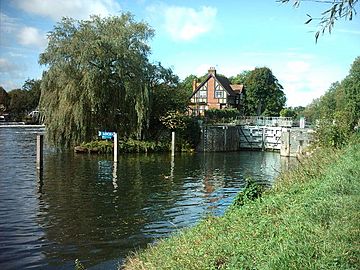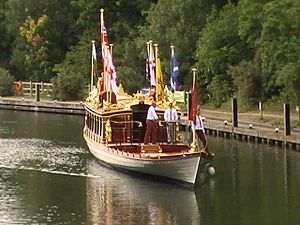Bray Lock facts for kids

Bray Lock, Buckinghamshire
|
|
| Waterway | River Thames |
|---|---|
| County | Buckinghamshire |
| Maintained by | Environment Agency |
| Operation | Hydraulic |
| First built | 1845 |
| Latest built | 1888 |
| Length | 40.94 m (134 ft 4 in) |
| Width | 5.46 m (17 ft 11 in) |
| Fall | 1.46 m (4 ft 9 in) |
| Above sea level | 69' |
| Distance to Teddington Lock |
29 miles |
Bray Lock is a special kind of water gate, called a lock, and a small dam, known as a weir, on the River Thames in England. It's located near the villages of Bray and Dorney Reach, just upstream from the M4 Bridge that crosses the Thames.
The lock is on the Buckinghamshire side of the river. This is opposite to Bray and Maidenhead, which are in Berkshire. The county line actually runs right down the middle of the Thames here. The lock was built by the Thames Navigation Commission in 1845. The person who looks after the lock, called the lock keeper, lives in a cottage on an island named Parting Eyot, which sits between the lock and the weir.
The weir is almost at the same level as the lock. It stretches straight across the river from the other side of the lock island to the opposite bank.
Contents
What is the History of Bray Lock?
There was a mill, which is a building that uses water power, at this spot way back in 1086. This was recorded in the Domesday Book, a famous survey of England. Later, in 1328, there was a mention of "Richard atte Lock of Bray" who managed a weir called Braibrok.
About 50 years later, in 1377, travelers complained about the high fees at a type of lock called a flash lock at this location, named Hameldon Lock. Both this lock and the weirs were removed in 1510 by order of the Commissioner of Sewers, who managed waterways.
In 1622, a new flash lock was built by Thomas Manfield. Records from 1632 also mention "water pens," which were likely early forms of water control. It's possible that boats used a different route, York Stream, which went on the other side of Bray towards Maidenhead, in earlier times.
A modern pound lock and weir were first suggested in 1833. This was to make it easier for boats to travel a few miles upstream. The river dropped a lot between Maidenhead and Boveney, causing shallow areas and strong currents. The path for horses to pull boats was on the Buckinghamshire side, but boats often traveled on the Berkshire side. This meant tow ropes had to cross the island.
The idea for a lock came up again in 1843. A lock house was built on Parting Eyot, and an open-sided lock was constructed the next year. The local miller helped pay for the weir. The lock was often left open unless the river was very low, and no tolls were collected. Solid sides were added to the lock before 1877. The lock and weir were rebuilt in 1885. Before this rebuilding, the famous writer Charles Dickens had described Bray Lock as a "rotten and dangerous structure."
What is the Area Above Bray Lock Like?
Right above Bray Lock is a small island called Headpile Eyot. On the Berkshire side of the river is Bray village, while the Buckinghamshire side has open fields. Further along the river is Brunel's famous Maidenhead Railway Bridge. This bridge is known as the "Sounding Bridge" because of the amazing echo you can hear underneath it.
The Maidenhead bank of the river is lined with large Edwardian houses. These stretch up to Maidenhead Bridge. Next to this bridge was once the Skindles Hotel. Along the banks of this part of the river, you can see many grand houses and boathouses. Some of these have been owned by famous British people.
Above the railway bridge are two more islands, Bridge Eyot and Grass Eyot. After these, you reach Boulter's Lock, with the village of Taplow on the Buckinghamshire side.
What Sports Events Happen Here?
The Maidenhead Regatta, a rowing competition, takes place below the railway bridge in August. After that, the annual Thames Punting Championships are held. Punting is a sport where you stand in a flat-bottomed boat and push it with a long pole. The Maidenhead Junior Regatta, for younger rowers, happens in May.
- Maidenhead Rowing Club is a local sports club.
Where Does the Thames Path Go?
The Thames Path is a long-distance walking trail. It follows the Buckinghamshire (Eastern) bank of the river until it reaches Maidenhead Bridge. The path then crosses the bridge and continues on the Berkshire side of the river towards Boulter's Lock.
Images for kids




